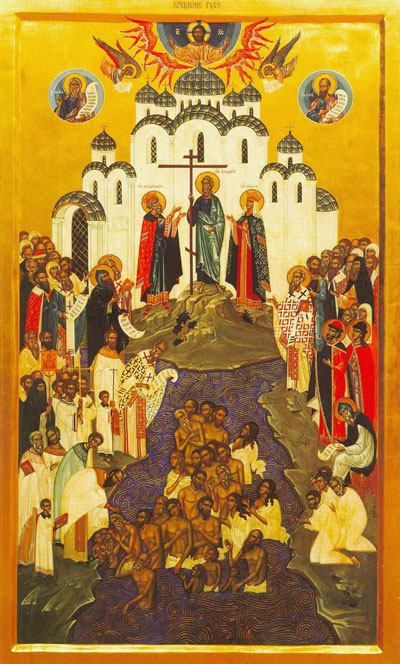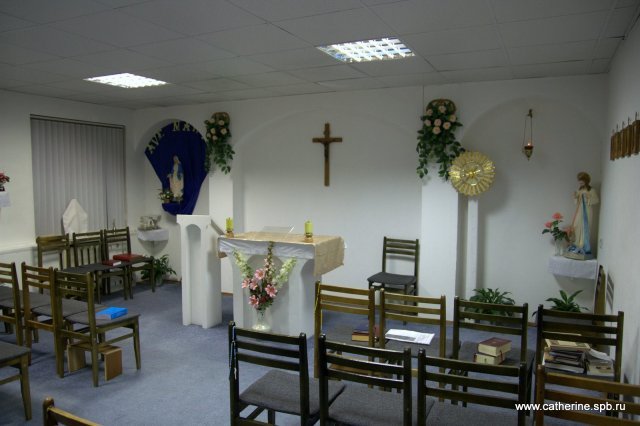 The most significant date in the Christianisation of the Eastern Slavonic peoples is the baptism of St Vladimir by missionaries from Constantinople in 988, from which Russians, Ukrainians and Byelorussians generally consider the Christian history of their countries to have begun. However, there were certainly Christians in those areas before that date, including Western Christians from what is now Germany and Hungary. Furthermore, the schism with Constantinople in 1054 did not immediately cut off the links between the Russian Church and Western Christians: we see this not least in a series of dynastic marriages, including the marriage of Great Prince Vladimir Monomakh to a daughter of King Harold II of England who had fled to the continent after the Norman Conquest.
The most significant date in the Christianisation of the Eastern Slavonic peoples is the baptism of St Vladimir by missionaries from Constantinople in 988, from which Russians, Ukrainians and Byelorussians generally consider the Christian history of their countries to have begun. However, there were certainly Christians in those areas before that date, including Western Christians from what is now Germany and Hungary. Furthermore, the schism with Constantinople in 1054 did not immediately cut off the links between the Russian Church and Western Christians: we see this not least in a series of dynastic marriages, including the marriage of Great Prince Vladimir Monomakh to a daughter of King Harold II of England who had fled to the continent after the Norman Conquest.By the time of the reassertion of Russian identity after the overthrow of the Mongols in the 14th century, however, the break between East and West was clear, and the Catholic presence in Russia was limited to a few foreign traders resident in Moscow and Novgorod.
Catholics came to Russia in large numbers in the 19th century as a result of the westward expansion of the Russian Empire into traditionally Catholic lands such as Poland and Lithuania: indeed, the arrival of Catholics in Siberia is tied in large part to the waves of Poles exiled there after the Polish uprisings of 1830 and 1863.

Church of St Catherine of Alexandria, Nevsky Prospekt, St Petersburg
There also arose in the late 19th century an interest in Catholicism in certain intellectual and aristocratic circles in Russia, not least as a result of the willingness with which the Orthodox Church appeared to submit to total control by the state. This movement, in fact, had a Dominican connection: once conversion to Catholicism was legalised in 1905, some of those from this circle who converted founded a Lay Dominican group in Moscow, as well as a community of Dominican sisters.
Hopes of greater religious freedom after the revolution of February 1917 were dashed by the October Revolution, and by the end of the 1920s there remained only two Catholic churches on the territory of what is now Russia, kept open for diplomats in Moscow and Leningrad. Many Catholics, clergy, religious and laity, were persecuted and martyred, and this persecution continued with varying degrees of intensity up to the 1980s (it should not be forgotten that other religious groups faced similar persecution, though Catholics were a particular target, as in China today, because they belonged to a worldwide organisation which the Soviet state could not even attempt to control).
Despite such persecution, however, many Catholics retained their faith, though without the opportunity to practise it: by the 1970s, there were also clandestine priests who had come to Russia from other parts of the Soviet Union and who were able to celebrate the sacraments in secret for those willing to take the risk. These underground Catholics maintained good relations with the dissident movement in the Orthodox Church, led by such figures as Fr Alexander Men, who attained huge popularity despite Soviet attempts to silence him.

Consecration of the altar of a new church in Tuapse, 2005
The changes of the early 1990s brought a new freedom for Catholics to practise their faith: many who had preserved the faith in secret came “out of the woodwork” to establish Catholic communities and parishes, and priests and religious came from around the world to help re-establish Church life. Efforts were made, with varying degrees of success, to reclaim churches confiscated after 1917, but the State often proved rather less willing to assist Catholics than Orthodox, so that in many places Catholics have either had to build new churches, if they have the money, or continue to worship either in a converted flat, as they do in the parish looked after by Dominicans in Yaroslavl, or even in the front room of a parishioner.

The chapel of the Catholic parish in Yaroslavl
Relations with the Orthodox are somewhat tense, with the Orthodox accusing Catholics of “proselytism” especially where they are engaged in charitable efforts beyond the Catholic community (e.g. running children’s homes or shelters for the homeless), which are perceived as attempts to convert ethnic Russians, who, as the argument goes, should by rights be Orthodox. Basically, it seems that the Orthodox (and the Russian state) will tolerate the Catholic Church as an “ethnic chaplaincy” to Poles, Lithuanians, Germans and other traditionally Catholic nationalities living in Russia, but they are very nervous about anything more than that. The establishment of four fully-fledged Catholic dioceses in Russia in 2002 was a low point in relations, though things do appear to have improved since then.

Meeting of the local Catholic and Orthodox bishop, Kazan 2009
The most generous estimate of the number of Catholics in Russia puts it at about 0.5% of the population. It is statistically insignificant, of course, but in such a huge country (the estimated total population is 143,000,000), that still means 789,000 Catholics.
As for the life of the Catholic community, the small numbers of Catholics in any one place and the great distances in Russia pose a particular problem for the maintenance of viable communities, and especially for priests ministering to them: the parish I lived in in Russia (I spent a year there as a languages student before I joined the Order) was bigger than Wales, and the furthest Mass station from the church, which a priest visited once a month, was a 500km round trip! Nevertheless, as so often in places with very small Catholic populations, the sense of community is strong, and the life of the parishes very active. Many parishes have communities of religious sisters living and working in them, but a significant proportion these, as well as of the priests, are still from outside Russia: the seminary in St Petersburg admits a reasonable number of seminarians each year, but it will take a long time to build up a local clergy to serve the 420 parishes in Russia, having started from so few in 1990.
Despite the various difficulties, then, the Catholic Church continues to grow in Russia, seeking to share the Good News in a country deprived of religion for over 70 years, but trying to do so in a way that respects as far as possible the thousand years of Christian history which went before.
No comments:
Post a Comment